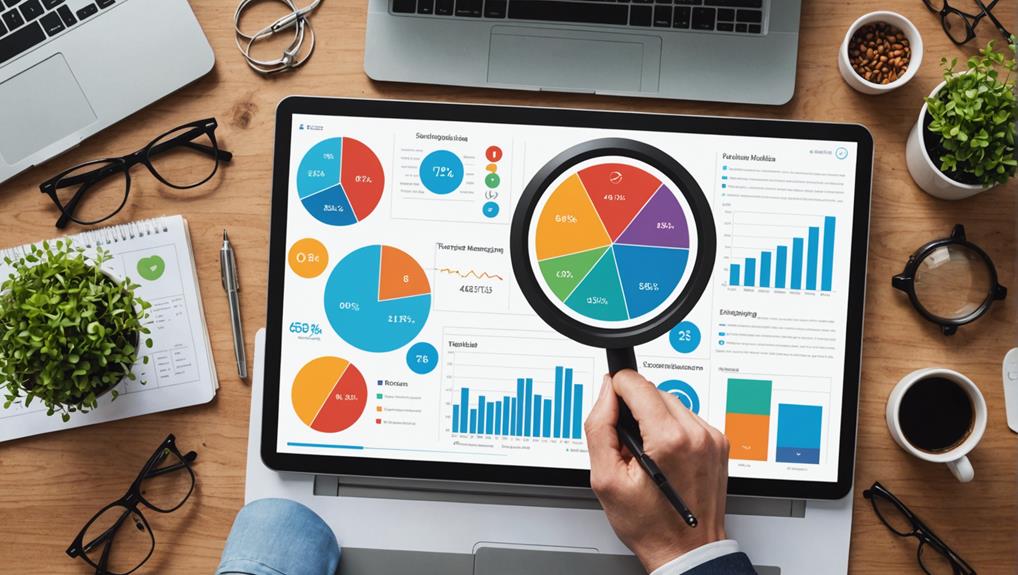To interpret social media analytics, start by tracking metrics like likes, comments, shares, and engagement rates. Use sentiment analysis to understand audience emotions. Regularly review these metrics to spot trends and adjust your strategy. Leverage tools like Google Analytics or Hootsuite for detailed reports. Set S.M.A.R.T. goals to measure success and align your social media efforts with broader business objectives. Analyze trends over time to optimize content. Competitive analysis can offer insights for improving your strategy. If you explore these elements further, you'll gain a more nuanced understanding of your social media performance.
Key Takeaways
- Analyze engagement rates to understand audience interaction and content effectiveness.
- Use sentiment analysis to gauge emotional responses and audience mood.
- Track reach and impressions to measure content visibility and exposure.
- Monitor conversion rates to assess the impact of social media on sales and leads.
- Identify trends and peak engagement times for strategic content planning.
Understanding Social Media Analytics
Understanding social media analytics starts with collecting and analyzing key metrics like likes, comments, shares, and mentions to gauge your account's performance. These metrics offer valuable insights into how well your content resonates with your audience.
By leveraging sentiment analysis, you can assess the emotional tone behind user interactions, helping you understand whether your audience's perception is positive, neutral, or negative.
To optimize your content, you need to dig deeper into these metrics. Identify which types of posts garner the most engagement and use this data to refine your strategy. Content optimization isn't just about producing more content; it's about creating the right kind of content that aligns with your audience's interests and behaviors.
Regularly reviewing your social media analytics allows you to spot trends and adjust your strategy in real-time. This proactive approach helps you avoid potential PR crises and capitalize on emerging trends.
Utilizing tools that generate performance reports can streamline this process, making it easier to share insights with your team and track progress toward your goals. By setting specific, measurable, attainable, relevant, and time-bound (SMART) goals, you can effectively monitor and enhance your social media performance.
Importance of Analyzing Social Media Data
Analyzing social media data is essential for measuring the effectiveness of your marketing efforts and understanding audience behavior. By employing data visualization techniques, you can easily interpret complex data sets, uncovering patterns and trends that drive engagement.
Audience segmentation allows you to tailor your content to specific groups, ensuring that your messages resonate more effectively with different segments of your audience.
Utilizing social listening strategies, you can monitor conversations about your brand, industry, and competitors. This real-time data helps you stay ahead of trends and respond proactively to potential challenges or opportunities.
Sentiment analysis adds another layer, providing insights into how your audience feels about your brand. Positive, negative, or neutral sentiments can guide your content strategy, enabling you to craft messages that align with your audience's emotions and preferences.
Regularly analyzing social media data helps you adjust tactics, optimize content, and enhance your overall social media presence. It allows you to set achievable goals and refine your strategies, ultimately maximizing your return on investment (ROI).
Key Metrics to Track
Monitoring key metrics in social media analytics is essential for evaluating the performance of your campaigns and making data-driven decisions.
Start with engagement rate, which measures how actively your audience interacts with your content through likes, comments, and shares. A high engagement rate indicates strong audience engagement and content performance, showing that your posts resonate well with your followers.
Next, track reach to understand how many unique users have seen your content. This metric is vital for gauging the potential audience size and ensuring your message is getting out there.
Impressions, on the other hand, reflect the total number of times your content has been displayed. While impressions alone don't guarantee engagement, they help you understand content visibility within your network.
Don't overlook click-through rate (CTR) and conversion rate. CTR measures the effectiveness of your call-to-action by calculating the percentage of users who clicked on a link in your post. A higher CTR usually means your content is compelling and relevant.
Tools for Social Media Analytics
To effectively leverage the key metrics you've tracked, utilizing specialized tools like Sprout Social, Google Analytics, Hootsuite, Buffer, and Brandwatch can provide deeper insights and streamline your social media analytics process. These tools offer extensive features that can help you transform raw data into actionable strategies.
Sprout Social stands out with its thorough analytics and reporting capabilities, enabling you to track social media performance with precision. Google Analytics offers invaluable insights on website traffic and social media referrals, enhancing your overall marketing strategies. Hootsuite's scheduling and performance monitoring functionalities help you make data-driven decisions seamlessly. Buffer is excellent for scheduling and analytics tracking, optimizing your content strategy for maximum impact. Brandwatch excels in social listening, sentiment analysis, and competitor benchmarking, giving you a strategic edge.
Here are some of the benefits these tools offer:
- Comparison tools: Compare your performance against competitors and industry benchmarks.
- Data visualization: Easily interpret complex data through intuitive graphs and charts.
- Automated reporting: Save time with scheduled reports that provide a snapshot of your social media performance.
- Sentiment analysis: Understand public perception and sentiment towards your brand.
Deploying these tools strategically will enhance your analytical capabilities and help you make informed decisions to boost your social media presence.
Setting S.M.A.R.T. Goals
Crafting S.M.A.R.T. goals guarantees that your social media strategy is focused, trackable, and aligned with measurable outcomes. In goal setting, make sure your objectives are Specific, Measurable, Achievable, Relevant, and Time-bound.
Specific goals clearly outline what you want to achieve, such as increasing brand awareness or boosting engagement rates. This precision enhances your strategy development, making it easier to direct efforts effectively.
Vital goals are important because they allow for data interpretation. By setting quantifiable targets—like aiming for a 20% increase in followers—you can track progress and determine success with concrete data. This measurement facilitates objective alignment, ensuring your social media efforts contribute to broader business objectives.
Achievable goals are realistic and consider your resources and capabilities. Setting attainable targets prevents overextension and keeps your team motivated. Relevant goals ensure that your efforts align with your overall business strategy, making them meaningful and impactful.
Analyzing Audience Behavior
Understanding audience behavior is crucial for tailoring your social media strategy to meet user preferences and maximize engagement. By analyzing metrics like engagement rate, follower growth, and post performance, you can uncover key insights into what resonates with your audience. This data-driven approach assists in audience segmentation and content personalization, guaranteeing your messages hit the mark.
To get a clearer picture of your audience's behavior, focus on:
- Demographics: Track age, gender, location, and device usage to understand who interacts with your content.
- Peak Engagement Times: Identify when your audience is most active to schedule posts for maximum visibility.
- Content Formats: Determine which formats (videos, images, text) garner the most interaction.
- Topics of Interest: Recognize the subjects that generate the most engagement and tailor your content accordingly.
Monitoring these aspects helps you craft content that aligns with your audience's preferences, boosting engagement and retention. By leveraging audience segmentation, you can deliver more targeted messages.
Content personalization, on the other hand, ensures your posts are relevant and appealing, ultimately driving better campaign results and a higher ROI. Use these strategies to refine your social media approach and connect more effectively with your audience.
Tracking Campaign Performance
To effectively track campaign performance, focus on key metrics like engagement rate and conversion metrics.
Use analytics tools to monitor these indicators and compare results across different platforms.
This data-driven approach allows you to fine-tune your strategies for maximum impact.
Engagement Rate Analysis
Engagement rate analysis offers a thorough metric for evaluating how effectively your social media campaigns capture and maintain audience interest. By measuring the level of interaction users have with your content—through likes, comments, shares, and clicks—you can gauge how well your posts resonate with your target audience. High engagement rates indicate successful content, while lower rates suggest areas for improvement.
To gain meaningful insights, compare your metrics against industry-specific engagement rate benchmarks. This will help you understand whether your performance is above or below average. Additionally, analyzing trends over time can guide your content optimization strategies, ensuring that you continually refine your approach to meet audience preferences.
Here's what to look for:
- Likes and comments: Measure the immediate emotional response and opinions of your audience.
- Shares: Assess how often users find your content valuable enough to share with their network.
- Clicks: Indicate interest and engagement, driving traffic to your website or other platforms.
- Overall engagement rate: Offers a thorough view of interaction levels across all types of engagement.
Conversion Metrics Evaluation
Conversion metrics serve as critical indicators of your social media campaign's effectiveness, tracking user actions like purchases, sign-ups, and downloads to measure ROI. By focusing on conversion rate analysis and cost optimization, you can refine your strategies to maximize campaign performance.
Key metrics to monitor include conversion rate, cost per conversion, return on ad spend (ROAS), and customer lifetime value (CLV). Let's break these down:
| Metric | Description | Importance |
|---|---|---|
| Conversion Rate | Percentage of users completing a desired action | Indicates campaign effectiveness |
| Cost per Conversion | Average cost to achieve one conversion | Aids in cost optimization |
| ROAS Calculation | Revenue generated per dollar spent on ads | Measures overall campaign profitability |
| CLV Impact | Total revenue expected from a customer over time | Helps assess long-term campaign value |
| Sign-ups/Downloads | Count of users signing up or downloading content | Tracks user engagement and interest |
Identifying Trends and Patterns
Spotting trends and patterns in social media analytics allows you to understand audience behavior and tailor your content strategy for maximum impact. By employing trend forecasting and pattern recognition, you can make informed decisions that enhance your social media performance.
Analyzing data helps you identify recurring themes or behaviors that resonate with your audience.
Consider the following insights:
- Peak Engagement Times: Determine when your audience is most active online to schedule posts for maximum visibility.
- Popular Content Formats: Recognize which types of content—videos, images, text posts—engage your audience the most.
- Audience Demographics: Understand the age, gender, and location of your followers to create more targeted content.
- Consistent Themes: Identify recurring topics that drive engagement to focus your content strategy.
Tracking these trends and patterns gives you a strategic advantage. For instance, if you notice a spike in engagement during weekends, you can plan to release your most important content then. Or, if videos consistently outperform other formats, prioritizing video content can boost your overall engagement.
Competitive Analysis
To stay ahead in the ever-evolving social media landscape, conducting a thorough competitive analysis allows you to benchmark your performance and uncover strategies that can enhance your own efforts. By engaging in competitor comparison, you gain valuable insights into how your rivals are performing across various metrics. This analysis helps you identify their strengths and weaknesses, enabling you to spot opportunities and threats in your own social media strategy.
Performance evaluation is key here. Track your competitors' engagement rates, follower growth, and content performance. Are they posting more frequently or during specific times? What types of content are driving the most interaction? By understanding these elements, you can refine your approach to better meet your audience's needs.
Additionally, competitor benchmarks guide you in setting realistic goals. If your competitors are achieving higher engagement rates, you can determine what they're doing differently and adjust your tactics accordingly. Analyzing their audience engagement can also help you identify gaps in your strategy and areas for improvement.
Utilizing competitive analysis isn't just about mimicking your competitors but making informed strategic decisions that enhance your overall social media marketing efforts. This targeted approach guarantees you remain competitive and relevant in your industry.
Measuring ROI and Impact
To measure ROI and impact effectively, track conversion rates to see how social media efforts translate into tangible results.
Analyze engagement rates to understand how well your content resonates with your audience.
Use metrics from influencer collaborations to assess their contribution to your brand's visibility and customer acquisition.
Conversion Tracking Techniques
Effectively measuring ROI and impact in social media marketing starts with implementing robust conversion tracking techniques. You need to understand how each social media interaction contributes to your goals. Tools like Google Analytics and Facebook Pixel are essential for setting up and tracking conversions, allowing you to attribute these actions to specific channels accurately.
To get started, focus on:
- Attribution modeling and conversion funnels: Understand the customer journey by mapping out each step users take before converting. This helps you identify which touchpoints are most influential.
- Multi-touch attribution and cross-channel tracking: Measure the impact of multiple interactions across different channels. This guarantees that every social media touchpoint is considered in your ROI analysis.
- Goal setting: Define clear objectives for your campaigns, such as clicks, sign-ups, or purchases, and track these goals rigorously.
- Data analysis: Regularly review conversion data to determine the effectiveness of your strategies. Use this information to optimize future campaigns.
Conversion tracking techniques give you a thorough view of how well your social media efforts are paying off. By leveraging these strategies, you can make data-driven decisions that enhance your marketing impact and maximize ROI.
Engagement Rate Analysis
Understanding how users interact with your content through engagement rate analysis is crucial for evaluating the true impact of your social media campaigns. By measuring follower interactions—likes, comments, and shares—you can gauge how well your content resonates with your audience. The engagement rate is calculated by dividing the total engagements by the total number of followers, providing a clear metric of audience connection and interest.
A high engagement rate signifies that your engagement strategies are effective, indicating strong audience connection and interest in the content. This metric isn't just about numbers; it reflects the quality of follower interactions and the depth of their connection to your brand.
To measure ROI and impact, monitor changes in engagement rates over time. This ongoing analysis provides insights into what types of content perform best and how your audience's preferences evolve. By strategically adjusting your content based on these insights, you can optimize your social media campaigns for maximum impact.
Incorporate these findings into your engagement strategies to refine your approach. This data-driven method ensures you're not just reaching your audience but truly engaging them, leading to more meaningful and impactful social media interactions.
Influencer Collaboration Metrics
When evaluating influencer collaborations, you'll need to track key metrics like engagement rates, click-through rates, and conversion rates to measure ROI and impact effectively. These metrics will help you understand influencer collaboration effectiveness and optimize engagement rates.
To guarantee you're getting the most out of your influencer partnerships, consider the following strategies:
- Use unique tracking links, promo codes, and UTM parameters: These tools allow you to attribute sales and conversions to specific influencers accurately.
- Analyze brand sentiment and audience perception: Sentiment analysis tools can reveal how influencer content is altering your brand's image.
- Assess reach, impressions, and post engagement: Measuring these can help you evaluate the influencer's performance and audience reach.
- Calculate Cost Per Acquisition (CPA) and Return on Ad Spend (ROAS): These financial metrics are essential for understanding the profitability of your influencer campaigns.
Frequently Asked Questions
How to Analyze Your Social Media Analytics?
To analyze your social media analytics, focus on trends in audience engagement and content strategy. Compare metrics to benchmarks, track campaign effectiveness, and use sentiment analysis to adjust your approach for better resonance and performance.
How to Understand Social Media Metrics?
To understand social media metrics, focus on engagement rate and reach growth. Analyze how likes, comments, and shares correlate with follower increases. This approach helps you make strategic, data-driven decisions for enhancing your social media strategy.
What Do You Understand by Social Media Analytics?
You analyze social media data to track metrics, perform sentiment analysis, and identify influencers. This helps you understand audience behavior, optimize strategies, and make data-driven decisions to maximize your social media marketing's impact.
How to Do a Social Media Analysis Report?
To do a social media analysis report, you'll collect metrics, use data visualization for clarity, and perform audience segmentation. Track engagement, reach, and ROI, then compare against competitors to refine your strategy.
Conclusion
By mastering social media analytics, you'll gain actionable insights and drive strategic decisions. Track key metrics with reliable tools and set S.M.A.R.T. goals to measure your campaign's performance effectively.
Identify trends and patterns to stay ahead of the competition. Finally, always measure ROI to guarantee your efforts are impactful.
Leveraging data not only optimizes your strategy but also boosts your social media presence, securing long-term success.




